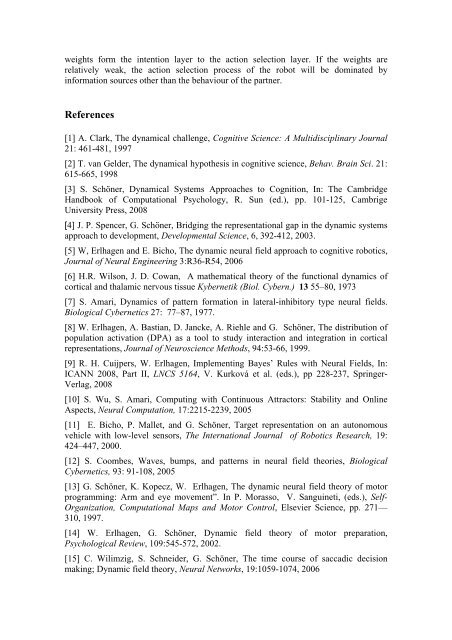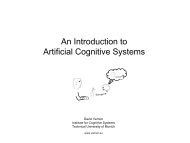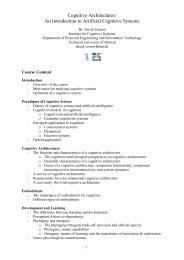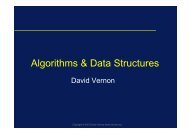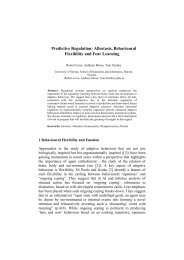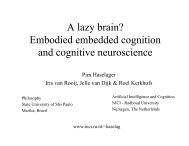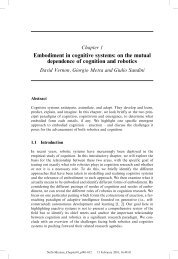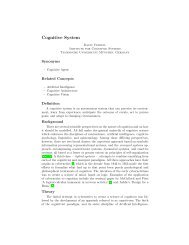Dynamic Field Theory (DFT): Applications in Cognitive Science and ...
Dynamic Field Theory (DFT): Applications in Cognitive Science and ...
Dynamic Field Theory (DFT): Applications in Cognitive Science and ...
You also want an ePaper? Increase the reach of your titles
YUMPU automatically turns print PDFs into web optimized ePapers that Google loves.
weights form the <strong>in</strong>tention layer to the action selection layer. If the weights are<br />
relatively weak, the action selection process of the robot will be dom<strong>in</strong>ated by<br />
<strong>in</strong>formation sources other than the behaviour of the partner.<br />
References<br />
[1] A. Clark, The dynamical challenge, <strong>Cognitive</strong> <strong>Science</strong>: A Multidiscipl<strong>in</strong>ary Journal<br />
21: 461-481, 1997<br />
[2] T. van Gelder, The dynamical hypothesis <strong>in</strong> cognitive science, Behav. Bra<strong>in</strong> Sci. 21:<br />
615-665, 1998<br />
[3] S. Schöner, <strong>Dynamic</strong>al Systems Approaches to Cognition, In: The Cambridge<br />
H<strong>and</strong>book of Computational Psychology, R. Sun (ed.), pp. 101-125, Cambrige<br />
University Press, 2008<br />
[4] J. P. Spencer, G. Schöner, Bridg<strong>in</strong>g the representational gap <strong>in</strong> the dynamic systems<br />
approach to development, Developmental <strong>Science</strong>, 6, 392-412, 2003.<br />
[5] W, Erlhagen <strong>and</strong> E. Bicho, The dynamic neural field approach to cognitive robotics,<br />
Journal of Neural Eng<strong>in</strong>eer<strong>in</strong>g 3:R36-R54, 2006<br />
[6] H.R. Wilson, J. D. Cowan, A mathematical theory of the functional dynamics of<br />
cortical <strong>and</strong> thalamic nervous tissue Kybernetik (Biol. Cybern.) 13 55–80, 1973<br />
[7] S. Amari, <strong>Dynamic</strong>s of pattern formation <strong>in</strong> lateral-<strong>in</strong>hibitory type neural fields.<br />
Biological Cybernetics 27: 77–87, 1977.<br />
[8] W. Erlhagen, A. Bastian, D. Jancke, A. Riehle <strong>and</strong> G. Schöner, The distribution of<br />
population activation (DPA) as a tool to study <strong>in</strong>teraction <strong>and</strong> <strong>in</strong>tegration <strong>in</strong> cortical<br />
representations, Journal of Neuroscience Methods, 94:53-66, 1999.<br />
[9] R. H. Cuijpers, W. Erlhagen, Implement<strong>in</strong>g Bayes’ Rules with Neural <strong>Field</strong>s, In:<br />
ICANN 2008, Part II, LNCS 5164, V. Kurková et al. (eds.), pp 228-237, Spr<strong>in</strong>ger-<br />
Verlag, 2008<br />
[10] S. Wu, S. Amari, Comput<strong>in</strong>g with Cont<strong>in</strong>uous Attractors: Stability <strong>and</strong> Onl<strong>in</strong>e<br />
Aspects, Neural Computation, 17:2215-2239, 2005<br />
[11] E. Bicho, P. Mallet, <strong>and</strong> G. Schöner, Target representation on an autonomous<br />
vehicle with low-level sensors, The International Journal of Robotics Research, 19:<br />
424–447, 2000.<br />
[12] S. Coombes, Waves, bumps, <strong>and</strong> patterns <strong>in</strong> neural field theories, Biological<br />
Cybernetics, 93: 91-108, 2005<br />
[13] G. Schöner, K. Kopecz, W. Erlhagen, The dynamic neural field theory of motor<br />
programm<strong>in</strong>g: Arm <strong>and</strong> eye movement”. In P. Morasso, V. Sangu<strong>in</strong>eti, (eds.), Self-<br />
Organization, Computational Maps <strong>and</strong> Motor Control, Elsevier <strong>Science</strong>, pp. 271—<br />
310, 1997.<br />
[14] W. Erlhagen, G. Schöner, <strong>Dynamic</strong> field theory of motor preparation,<br />
Psychological Review, 109:545-572, 2002.<br />
[15] C. Wilimzig, S. Schneider, G. Schöner, The time course of saccadic decision<br />
mak<strong>in</strong>g; <strong>Dynamic</strong> field theory, Neural Networks, 19:1059-1074, 2006


